.....When I was learning how to play
pool there were no books, no videos, no instructors and no leagues
to play in. The best way to learn was to watch. I was privileged
to see some of the greatest and some of the not so great. My
purpose for publishing my pointers insrtuctional column is not
only to inpart pool knowledge to my viewers but to share with the
public what these great players from the 1980s and 1990s looked
like. Through my trusty Canon, for a moment in time they are immortalized.
Some are still here and some are gone and I still remember the
joy of watching them play.

NEED HELP IN READING THE RIGHT ANGLE?
A Useful Tool May Already Be In Your Hands
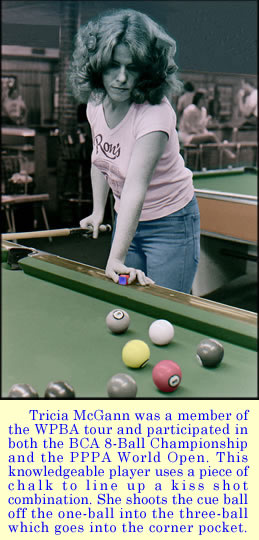
.....VISUALIZATION IS AN IMPORTANT aspect of any billiard game and the pool player should use the tools of the trade to conceptualize their next move. In the photographed circumstances, Tricia McGann and Mike Sigel used what was available to them to aid in making their respective combinations.
.....Let’s first define our terms. In my book, “Pool Pointers”, I describe four different types of combinations. The first two types involve one object ball being shot into another. A ‘regular’ combination or ‘combo’ is hitting one ball into another when there is a space wider than one eighth of an inch between them. Then there’s a throw shot, again, one object ball is shot into another but this time there is no space or only one eighth of an inch between the two balls that make up the throw. The second two types are combinations involving a ball, be it the cue ball or an object ball, glancing off another into the desired target ball. Every time the cue ball and object balls bounce off one another on a pool table they are said to be “caroming”. If there is no space between two object balls or up to an eighth of an inch it’s called a carom shot and if the space is wider than that it’s called a “kiss shot”. I make precise definitions of these types of shots because the principles in successfully pocketing these four different groups are different.
.....Tricia McGann faces a troubling kiss shot situation at the 1980 Eastern States Championship hosted by Sy & Dolly Eckstadt. In a game of nine ball, in order to continue her run, Tricia had to figure out the carom line to shoot the cue ball off the one-ball andinto the three-ball. She used a piece of chalk to help her figure out the deflection line. One can see from the photograph how Tricia lined up the side (her left) of the chalk to envision the line. Since the deflection line needed to be shortened, making a v-bridge off the rail helped her to maintain a level cue to address the top of the cue ball which shortened the angle. (See my article “V-bridge It To Victory” on page 7.) Tricia, using a slow speed, which also helped in shortening the angle, was able to bounce the cue ball off the one-ball and pocketed the three-ball in the corner pocket.
.....Mike Sigel continually comes up in my critiques not only because of his prowess as a winner but because he is such an imaginative player. But dear reader, I digress…
.....The shot Sigel faces in the photo is widely referred to as a "ball-first carom." In my mind, there must be some verbiage to describing the difference between shots with a space or no space. Therefore, I call these types of shots, where one ball caroms off another when there is a space between them, “kiss shots.”
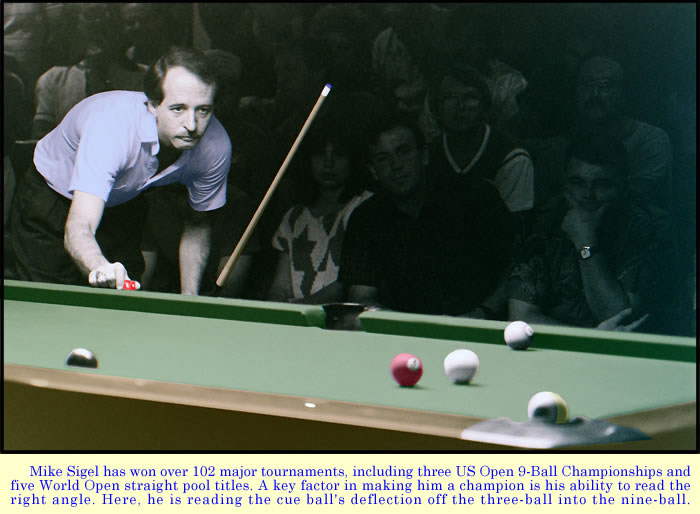
.....In this nine ball situation, Mike is on the 3 ball. The game winning 9 ball is hanging in the corner pocket. Sigel's plan is to carom the cue ball off of the 3, and into the 9. The right-angle principle suggests that, with a middle cue ball hit at medium speed (and, of course, a level cue), the cue ball will travel off a right angle from the contact point on the first object ball.
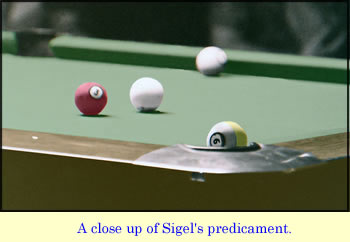 .....To aid him in "reading" the shot, Mike is using a piece of chalk. He discovers that he needs to widen the cue ball's deflection because the 9 ball is sitting below the natural, right angle. Hence, he strikes the cue ball one tip below center using a flat draw. One can also widen the deflection angle by elevating the cue stick. In this case, Mike has to have perfect control over the cue ball so he doesn't scratch after making the nine. The flat draw gives him more control of the cue ball than stick elevation. Learning how to carom your cue ball off object balls will give you valuable information about cue ball positioning. By the way, Sigel read this shot correctly and his carom won the game. .....To aid him in "reading" the shot, Mike is using a piece of chalk. He discovers that he needs to widen the cue ball's deflection because the 9 ball is sitting below the natural, right angle. Hence, he strikes the cue ball one tip below center using a flat draw. One can also widen the deflection angle by elevating the cue stick. In this case, Mike has to have perfect control over the cue ball so he doesn't scratch after making the nine. The flat draw gives him more control of the cue ball than stick elevation. Learning how to carom your cue ball off object balls will give you valuable information about cue ball positioning. By the way, Sigel read this shot correctly and his carom won the game.
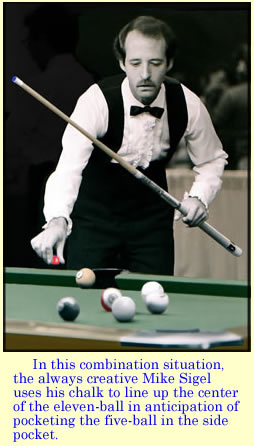
.....In the other pictured example, Mike is faced with a regular combination, the eleven into the five into the side pocket. He used the same chalk technique as before to sight the combination during this straight pool tournament. Never letting go of the chalk, Sigel used it to line up the center of the eleven-ball for making the combo. Since the balls are round, in pool especially, the point of aim and the point of contact are never in the same place unless they are lined up straight for the pocket. Notice that Mike is figuring out where the center of the eleven-ball is aimed when its right side contacts the left side of the five-ball. Using medium speed and a level cue stick, Sigel was able to continue his 68 ball run. As in golf, as long as the player keeps the equipment in their hand, without placing it anywhere on the playing field, they can use the item to help line up their shot.
.....Using the tools of the trade is an important aspect of being proficient in any sport. In my view, it's part of defining a sport and is widely used by TV and radio commentators to describe a player’s expertise in a given sport. Since the billiard industry is still struggling to be recognized as a sport, I hope the billiard organizations refrain from outlawing the practice.
 . .
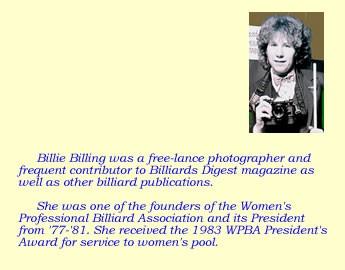
.....Pool Pointer Archives
.....1. Closed Half-Bridge
... .2. Look Before You Leap
.....3. Mechanically Inclined
.....4. Keep A Level Cue
.....5. Double or Nothing
.....6. Chalk It Up
.....7. V-Bridge It To Victory
.....8. The Right Combination
.....9. Referees; unsung heros
...10. Don't Lag Behind
...11. Tongue Twister; Mouth Pool
...12. Need Help In Reading The Right Angle?
.....Tune
in for more Pointer articles coming
your way each month.

|

